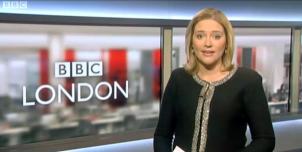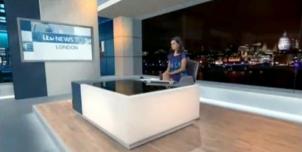Full Freeview on the Crystal Palace (Greater London, England) transmitter
| Google Streetview | Google map | Bing map | Google Earth | 51.424,-0.076 or 51°25'26"N 0°4'32"W | SE19 1UE |
The symbol shows the location of the Crystal Palace (Greater London, England) transmitter which serves 4,490,000 homes. The bright green areas shown where the signal from this transmitter is strong, dark green areas are poorer signals. Those parts shown in yellow may have interference on the same frequency from other masts.
_______
Digital television services are broadcast on a multiplexes (or Mux) where many stations occupy a single broadcast frequency, as shown below.
64QAM 8K 3/4 27.1Mb/s DVB-T MPEG2
DTG-12 QSPK 8K 3/4 8.0Mb/s DVB-T MPEG2
H/V: aerial position (horizontal or vertical)
Which Freeview channels does the Crystal Palace transmitter broadcast?
If you have any kind of Freeview fault, follow this Freeview reset procedure first.Digital television services are broadcast on a multiplexes (or Mux) where many stations occupy a single broadcast frequency, as shown below.
64QAM 8K 3/4 27.1Mb/s DVB-T MPEG2
DTG-12 QSPK 8K 3/4 8.0Mb/s DVB-T MPEG2
H/V: aerial position (horizontal or vertical)
Which BBC and ITV regional news can I watch from the Crystal Palace transmitter?

BBC London 4.9m homes 18.4%
from London W1A 1AA, 12km north-northwest (335°)
to BBC London region - 55 masts.

ITV London News 4.9m homes 18.4%
from London WC1X 8XZ, 11km north-northwest (345°)
to ITV London region - 55 masts.
Are there any self-help relays?
| Charlton Athletic | Transposer | Redeveloped north stand Charlton Athletic Football Club | 130 homes |
| Deptford | Transposer | south-east London | 100 homes |
| Greenford | Transposer | 12 km N Heathrow Airport | 203 homes |
| Hendon | Transposer | Graham Park estate | 50 homes |
| White City | Transposer | 9 km W central London | 80 homes |
How will the Crystal Palace (Greater London, England) transmission frequencies change over time?
| 1950s-80s | 1984-97 | 1997-98 | 1998-2012 | 2012-13 | 21 Mar 2018 | ||||
| VHF | A K T | A K T | A K T | A K T | W T | ||||
| C1 | BBCtvwaves | ||||||||
| C22 | ArqA | ArqA | |||||||
| C23 | ITVwaves | ITVwaves | ITVwaves | BBCA | BBCA | ||||
| C25 | SDN | SDN | |||||||
| C26 | BBC1waves | BBC1waves | BBC1waves | D3+4 | D3+4 | ||||
| C28 | -ArqB | ArqB | |||||||
| C29 | LW | ||||||||
| C30 | C4waves | C4waves | C4waves | -BBCB | BBCB | ||||
| C33 | BBC2waves | BBC2waves | BBC2waves | com7 | |||||
| C35 | com8 | ||||||||
| C55tv_off | com7tv_off | ||||||||
| C56tv_off | COM8tv_off |
tv_off Being removed from Freeview (for 5G use) after November 2020 / June 2022 - more
Table shows multiplexes names see this article;
green background for transmission frequencies
Notes: + and - denote 166kHz offset; aerial group are shown as A B C/D E K W T
waves denotes analogue; digital switchover was 4 Apr 12 and 18 Apr 12.
How do the old analogue and currrent digital signal levels compare?
| Analogue 1-4 | 1000kW | |
| SDN, ARQA, ARQB, BBCA, D3+4, BBCB | (-7dB) 200kW | |
| com7 | (-13.7dB) 43.1kW | |
| com8 | (-14dB) 39.8kW | |
| Mux 1*, Mux 2*, Mux A*, Mux B*, Mux C*, Mux D*, LW | (-17dB) 20kW |
Local transmitter maps
Crystal Palace Freeview Crystal Palace DAB Crystal Palace TV region BBC London LondonWhich companies have run the Channel 3 services in the Crystal Palace transmitter area
|
|
Sunday, 1 October 2017
J
JohnM3:41 PM
I agree with Jamie and, at first, I couldn't understand why the change was being made as it will inconvenience a lot of people and CP doesn't use any 700 MHz frequencies anyway. The reason, I realise (and I must have missed this if it has been discussed before), is that Com7 and Com8 are going to become Single Frequency Networks.
| link to this comment |
J
JohnM3:46 PM
Hang on a minute! I've just looked at Brian's "Bingo card" and see that the proposed UHF channels for Com7 and Com8 are right in the middle of the 700MHz space that is to be cleared. Can someone explain, please?
| link to this comment |
S
StevensOnln111:16 PM
JohnM: COM7 & COM8 are expected to close in 2020 when the 700MHz frequency clearance is completed (this may be extended until 2022 depending on what Ofcom decide to do with the centre gap between the uplink and downlink frequencies that 4G/5G services in the 700MHz band will use) so they will either close before any 4G/5G services start on the 700MHz band or co-exist with them for a couple of years (although anyone close enough to a cellular mast to need the 700MHz band filtered out on their aerial once 4G/5G transmissions start will also loose COM7 & COM8 once the filter is installed).
| link to this comment |
Monday, 2 October 2017
S
Scott9:05 PM
Any ideas what will happen to the BBC channels presently on Com7
| link to this comment |
Tuesday, 3 October 2017
MikeP
4:31 PM
4:31 PM
Scott:
It is expected that all, or at least most, of the channels on COM7 and COM8 will be subsumed into the multiplexes available when the forthcoming planned changes are implimented. I have no details of what will move where nor of which channels will remain and which will cease (if any).
| link to this comment |
Monday, 9 October 2017
S
Scott10:02 PM
Will this mean a reduction in the HD bitrate to fit them in?
| link to this comment |
Tuesday, 10 October 2017
MikeP
10:34 AM
10:34 AM
Scott:
It is not expected that there will be any reduction in the HD bit rate. What is planned to happen is that more services will be broadcast using DVB-T2 encoding which is a lot more efficient and allows for more channels to be carried by a multiplex than is currently the case. Hence the expected abilitry to broadcast more HD channels and more channels without using the Com7 or Com8 services which will disappear.
| link to this comment |
Sunday, 15 October 2017
S
Stuart9:12 AM
I am on the edge of the Crystal Palace reception area in Bucks. Consequently my aerial is mounted on a high mast. I bought a new 4k Hitachi TV yesterday. It does not pick up any channels from BBCB or COM7 muxes. At one stage it did register BBC4 HD (COM7) but I have since lost that. My previous Panasonic TV did not have this problem although I occasionally got service interruption and pixelation on the HD channels that are broadcast by these muxes.
Any suggestions as to how I might resolve the issue and/or why I only experience this problem on a new TV and specific muxes? Thanks.
| link to this comment |
MikeP
11:03 AM
11:03 AM
Stuart:
Different TV sets have different sinsitivities of the tuner unit - even ones of thre same make.
We need to know what the TV set shows as the signal strengths of the received multiplexes are, including the ones giving problems, if possible. Your User Manual will tell you how to get that displayed. For SD channels you need a strength of between 50% and 85% and for the HD services you need between 60% and 85% for reliable reception. Note that Com7 and Com8 are lower power than the main services, so are likely to be more prone to problems.
It would also be useful to us if you would give a full post code for your location as then we can look up what the reception conditions are likely to be.
| link to this comment |
S
Stuart10:36 PM
Beaconsfield
Thanks Mike. The signal strength and quality are both barely registering (under 10%) when I do manual tune for those muxes with occasional spikes on strength but not quality. My post code is HP9 1BW. Strictly I think we may be about 10 metres off the Crystal Palace map. We are at the top of a hill. Our neighbours have resorted to FreeSat and maybe we'll have to do the same. I think the previous owners of our house erected a tall mast to compensate for the slope we are very much towards the top of. Do you think a high gain aerial might do the trick?
| link to this comment |
Stuart's: mapS's Freeview map terrainS's terrain plot wavesS's frequency data S's Freeview Detailed Coverage
Select more comments
Your comment please





